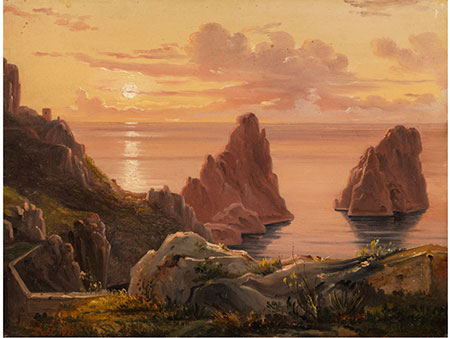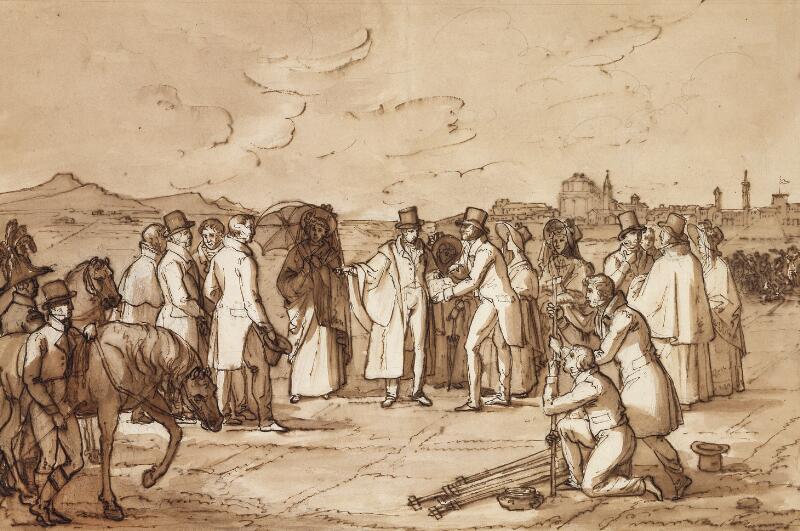I. C. Dahl (b. Bergen 1788, d. Dresden 1857) “Klintekorset i Liselunds Hauge paa Möen”. From the garden at Liselund. Signed and dated Dahl 1814. Oil on canvas. 78×53 cm. KURSIV Elisabeth Lødrup Bang, A Catalogue Raisonné of the Works of Johan Christian Dahl No. 59. The size and whereabouts of the painting were not known when Lødrup Bang registered Dahl's paintings for her publication. A drawing of the painting is reproduced in vol. 3, plate no. 26, ill. no. 59. Ny Carlsberg Glyptotek owns a similar but far from identical motif of “Klintekorset” (Cross on a Cliff), dated 1815 with the measurements 52.5×42 cm (inv. no. NCC M.I.N. 3573). In the present painting, the cliff with the cross takes up the left side of the painting, and the blue, slightly cloudy, sky fills the right side, while the large cliff with the cross on top more or less dominates all of the image in the painting from the Glyptotek from 1815. Provenance: High Commissioner of War Johan Christian Fick, Copenhagen. Fick also owned “Parti fra Liselund Park på Møn”, (View from Liselund Park on Møn), (measuring 78×62 cm) (Elisabeth Bang no. 58). Dahl mentions in a letter to Petersen, the owner of Engelholm, on 24 January 1815, that he has completed two paintings for Fick. This is most likely a reference to “Liselund Park” and “Klintekorset”. Johan Christian Fick (1787–1864) was not just anyone. He had, among other things, the idea to establish an art society in Copenhagen inspired by an international model and together with the professors at the Academy J.L. Lund (1777–1867), C.W. Eckersberg (1783–1853) and G.F. Hetsch (1788–1864), landscape painter I.P. Møller (1783–1854), the art historian N.L. Høyen (1798–1870) and the secretary J. M. Thiele (1795–1874), he established Kunstforeningen (the Art Society) in 1825 and became the first chairman. Johan Christian Claussen Dahl was born in 1788 in Bergen and died in Dresden in 1857. He was a Norwegian landscape painter and one of the founders of the romantic style of art, which arose in the early 1800s. He is considered the father of the Norwegian landscape painting. When he was 24, he travelled from Bergen to Copenhagen in 1811 to study at the Royal Danish Academy of Fine Arts. Painting landscapes was not taught at the Academy, so Dahl took private lessons with the professor at the Academy Christian August Lorentzen (1749–1828), who had been in Norway in 1792. The trip was paid for by the Danish king, and Lorentzen’s mission was to paint the wild and magnificent landscapes so different from the Danish landscape. It therefore made good sense for Dahl to receive lessons from Lorentzen. The Dutch style of painting from the 17th century also had an influence on Dahl's development as an artist. Early on, he copied several of the great Dutch landscape painters and was inspired by them, including names such as Jan Both (1610–1652), Meindert Hobbema (1638–1709) and Jacob van Ruisdael (1628–1682). He was familiar with the landscapes of the Danish painter Jens Juel (1745–1802) and with C.W. Eckersberg's series of paintings from the romantic landscapes around Liselund in 1809. Eckersberg is considered the artist who “discovered” Møn and the wonders of the island. Of course, Dahl has been aware of this. Eckersberg's “Korsklinten ved Liselund på Møn” (Cross Cliff at Liselund on Møn), 1809 (The David Collection, inv. no. 28/1970), can be highlighted as a strong source of inspiration for Dahl, especially compared to the above-mentioned painting belonging to the Glyptotek. A study trip to the southern part of Zealand also had an impact on Dahl’s artistic development. Here he lived at Engelholm Manor near Præstø in 1814. From here he made excursions, including: “a picturesque journey by foot from Liselund to the great cliffs”, which he describes as a highlight during his stay. The varied terrain with the steep limestone cliffs and the lush and magnificent nature attracted him. It is probably one of the few places in Denmark that can match
Condition
I. C. Dahl (b. Bergen 1788, d. Dresden 1857) “Klintekorset i Liselunds Hauge paa Möen”. From the garden at Liselund. Signed and dated Dahl 1814. Oil on canvas. 78×53 cm. KURSIV Elisabeth Lødrup Bang, A Catalogue Raisonné of the Works of Johan Christian Dahl No. 59. The size and whereabouts of the painting were not known when Lødrup Bang registered Dahl's paintings for her publication. A drawing of the painting is reproduced in vol. 3, plate no. 26, ill. no. 59. Ny Carlsberg Glyptotek owns a similar but far from identical motif of “Klintekorset” (Cross on a Cliff), dated 1815 with the measurements 52.5×42 cm (inv. no. NCC M.I.N. 3573). In the present painting, the cliff with the cross takes up the left side of the painting, and the blue, slightly cloudy, sky fills the right side, while the large cliff with the cross on top more or less dominates all of the image in the painting from the Glyptotek from 1815. Provenance: High Commissioner of War Johan Christian Fick, Copenhagen. Fick also owned “Parti fra Liselund Park på Møn”, (View from Liselund Park on Møn), (measuring 78×62 cm) (Elisabeth Bang no. 58). Dahl mentions in a letter to Petersen, the owner of Engelholm, on 24 January 1815, that he has completed two paintings for Fick. This is most likely a reference to “Liselund Park” and “Klintekorset”. Johan Christian Fick (1787–1864) was not just anyone. He had, among other things, the idea to establish an art society in Copenhagen inspired by an international model and together with the professors at the Academy J.L. Lund (1777–1867), C.W. Eckersberg (1783–1853) and G.F. Hetsch (1788–1864), landscape painter I.P. Møller (1783–1854), the art historian N.L. Høyen (1798–1870) and the secretary J. M. Thiele (1795–1874), he established Kunstforeningen (the Art Society) in 1825 and became the first chairman. Johan Christian Claussen Dahl was born in 1788 in Bergen and died in Dresden in 1857. He was a Norwegian landscape painter and one of the founders of the romantic style of art, which arose in the early 1800s. He is considered the father of the Norwegian landscape painting. When he was 24, he travelled from Bergen to Copenhagen in 1811 to study at the Royal Danish Academy of Fine Arts. Painting landscapes was not taught at the Academy, so Dahl took private lessons with the professor at the Academy Christian August Lorentzen (1749–1828), who had been in Norway in 1792. The trip was paid for by the Danish king, and Lorentzen’s mission was to paint the wild and magnificent landscapes so different from the Danish landscape. It therefore made good sense for Dahl to receive lessons from Lorentzen. The Dutch style of painting from the 17th century also had an influence on Dahl's development as an artist. Early on, he copied several of the great Dutch landscape painters and was inspired by them, including names such as Jan Both (1610–1652), Meindert Hobbema (1638–1709) and Jacob van Ruisdael (1628–1682). He was familiar with the landscapes of the Danish painter Jens Juel (1745–1802) and with C.W. Eckersberg's series of paintings from the romantic landscapes around Liselund in 1809. Eckersberg is considered the artist who “discovered” Møn and the wonders of the island. Of course, Dahl has been aware of this. Eckersberg's “Korsklinten ved Liselund på Møn” (Cross Cliff at Liselund on Møn), 1809 (The David Collection, inv. no. 28/1970), can be highlighted as a strong source of inspiration for Dahl, especially compared to the above-mentioned painting belonging to the Glyptotek. A study trip to the southern part of Zealand also had an impact on Dahl’s artistic development. Here he lived at Engelholm Manor near Præstø in 1814. From here he made excursions, including: “a picturesque journey by foot from Liselund to the great cliffs”, which he describes as a highlight during his stay. The varied terrain with the steep limestone cliffs and the lush and magnificent nature attracted him. It is probably one of the few places in Denmark that can match
Condition









.jpg)

Try LotSearch and its premium features for 7 days - without any costs!
Be notified automatically about new items in upcoming auctions.
Create an alert